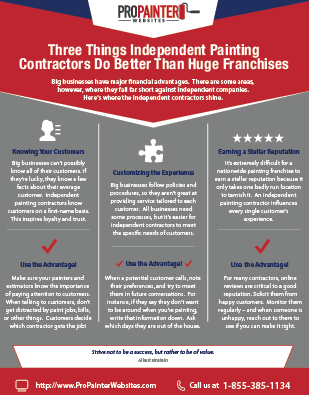Crucial Seasonal Aspects Of Commercial Outside Paint: What You Must Recognize
Crucial Seasonal Aspects Of Commercial Outside Paint: What You Must Recognize
Blog Article
Material Written By-Burnham Decker
When you're planning a business outside paint job, seasonal elements can make or damage your outcomes. You'll want to take into consideration how temperature level and moisture influence paint application and drying times. Picking the best season can guarantee your paint sticks correctly and lasts longer. Yet which periods are truly the very best for this kind of work? Let's discover the key elements that can affect your job's success.
The Effect of Temperature on Paint Application
When you're intending an industrial outside paint job, the temperature level can substantially affect just how well the paint adheres and dries.
Ideally, you want to paint when temperature levels vary in between 50 ° F and 85 ° F. If it's as well cold, the paint might not treat correctly, bring about concerns like peeling or cracking.
On the flip side, if it's as well hot, the paint can dry too rapidly, protecting against correct attachment and causing an unequal finish.
house painters sand springs need to likewise think about the moment of day; early morning or late afternoon uses cooler temperature levels, which can be a lot more favorable.
Constantly check https://independent-painters-near57665.liberty-blog.com/35183302/keep-a-clear-vision-and-foster-open-communication-to-achieve-optimal-outcomes-with-your-painting-firm-learn-just-how-to-bring-this-to-fruition for the certain paint you're utilizing, as they commonly give advice on the suitable temperature range for ideal outcomes.
Humidity and Its Effect on Drying Times
Temperature level isn't the only environmental variable that influences your business exterior painting project; moisture plays a significant function as well. High humidity degrees can slow down drying times dramatically, influencing the general high quality of your paint job.
When the air is filled with dampness, the paint takes longer to heal, which can cause concerns like bad bond and a higher threat of mildew growth. If you're painting on a specifically humid day, be planned for prolonged delay times in between coats.
It's crucial to keep track of local weather and strategy accordingly. Preferably, go for moisture levels in between 40% and 70% for optimal drying out.
Keeping these factors in mind guarantees your job remains on track and supplies a long lasting finish.
Best Seasons for Commercial Outside Painting Projects
What's the best season for your commercial exterior painting tasks?
Springtime and early loss are generally your best choices. Throughout these seasons, temperature levels are moderate, and moisture levels are typically reduced, creating optimal conditions for paint application and drying.
Avoid summer season's intense heat, which can create paint to completely dry as well swiftly, causing inadequate attachment and finish. Likewise, winter's chilly temperatures can impede proper drying out and curing, taking the chance of the long life of your paint job.
Go for days with temperature levels in between 50 ° F and 85 ° F for ideal results. Keep in mind to examine the regional weather forecast for rainfall, as damp problems can destroy your task.
Planning around these elements ensures your painting job runs efficiently and lasts much longer.
Verdict
Finally, intending your business outside paint jobs around seasonal considerations can make a substantial difference in the result. By contractors throughout the perfect temperature levels and moisture levels, you'll ensure better bond and drying out times. Remember to watch on local weather forecasts and select the right time of year-- springtime and very early loss are your best choices. Taking these actions will assist you achieve a sturdy and professional coating that lasts.
